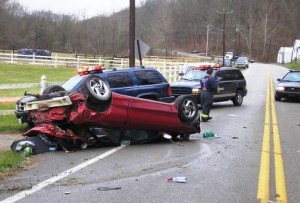
Government data reveals that while highway fatalities are declining, distracted driving deaths are up..
U.S. traffic fatalities continue to plunge, reaching their lowest level since 1949, well before the creation of the American interstate highway system.
According to estimates from the National Highway Traffic Safety Administration, 32,310 people died in traffic accidents in 2011, a 1.7% year-over-year decline. That marks the seventh consecutive year that the death rate has declined.
Since just 2005, traffic fatalities have fallen by more than 25% — and when measured in terms of deaths per mile driven the figure has reached its lowest level since record-keeping began in 1921, according to NHTSA.
While federal officials declined to point to specific factors, experts suggest there are several reasons behind the sharp drop. These include a crackdown on drunk driving – which some once linked to as many as half of all highway deaths – increased use of seatbelts and improved vehicle design complying with stricter federal safety requirements. In just the last several years, NHTSA has mandated the installation of electronic stability control systems on all new vehicles, along with tougher roof crush standards.
But some experts also point to the economic downturn which has been credited – or blamed – for a sharp drop in the number of miles the average American has been driving in recent years. The preliminary NHTSA study shows U.S. motorists collectively drove 35.7 billion vehicle miles fewer in 2011 than the year before – a 1.2% decline. As the economy recovers, some observers warn, fatalities could rise as people again drive more.
But even when adjusted to an apples-to-apples, the death rate is down, reaching a low of 1.09 for every 100 million miles driven compared to 1.11 deaths in 2010. At its peak, that was closer to 7 per 100 million vehicle miles.
As recently as 2005, traffic accidents were responsible for 43,510 deaths in the United States – a figure that includes pedestrian fatalities.
The decline varied by region, and New England experienced the biggest drop, fatalities down by 7.2% last year. In the American heartland, including Kansas, Missouri and Nebraska, the death toll dipped 5.3%. But the three-state region including Hawaii, California and Arizona bucked the trend, with fatalities actually increasing by 3.3% last year.
Despite the overall decline, Transportation Secretary Ray LaHood has repeatedly said the traffic fatality rate is still too high and is pressing for further efforts to bring it down. The agency is in the preliminary stages of preparing new rules to address what LaHood has described as an “epidemic” of distracted driving deaths.
NHTSA, meanwhile, is proposing new rules that would mandate a brake-throttle override, a system that would cut engine power if a motorist were to inadvertently hit both the brake and throttle at the same time. Such driver error has been blamed, in many cases, for reports of so-called unintended acceleration.

Perhaps the fact that Echo-Boomers/Gen-Y folks really aren’t as intersted in driving (some not at all)is a factor. When I was young growing up, kids couldn’t wait to get a DL and on weekends, undoubtedly mixing cars, inexperienced driver skill, some drinking and the need to showing off would be a recipe for bad things.
There’s definitely a shift in attitude, Steve. Check out our Scion report going up later today.
Paul E.